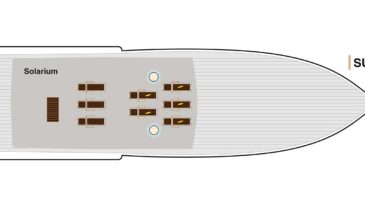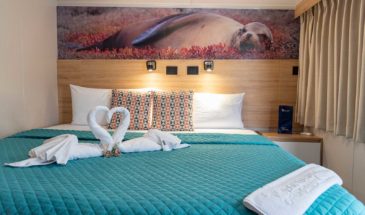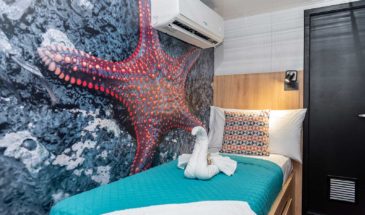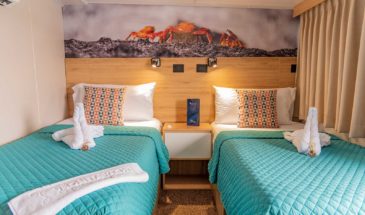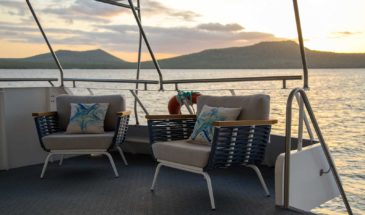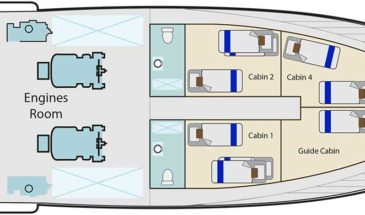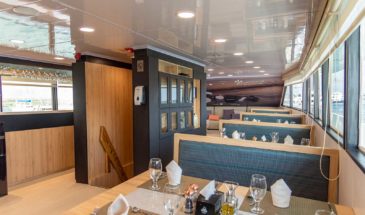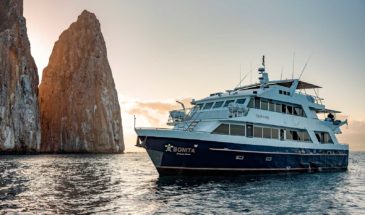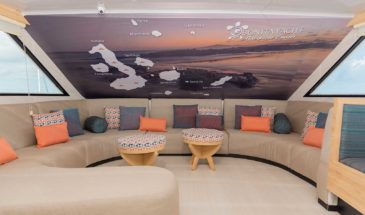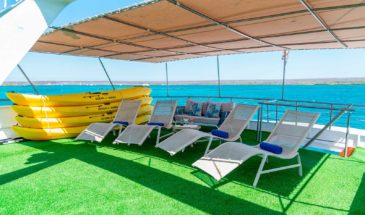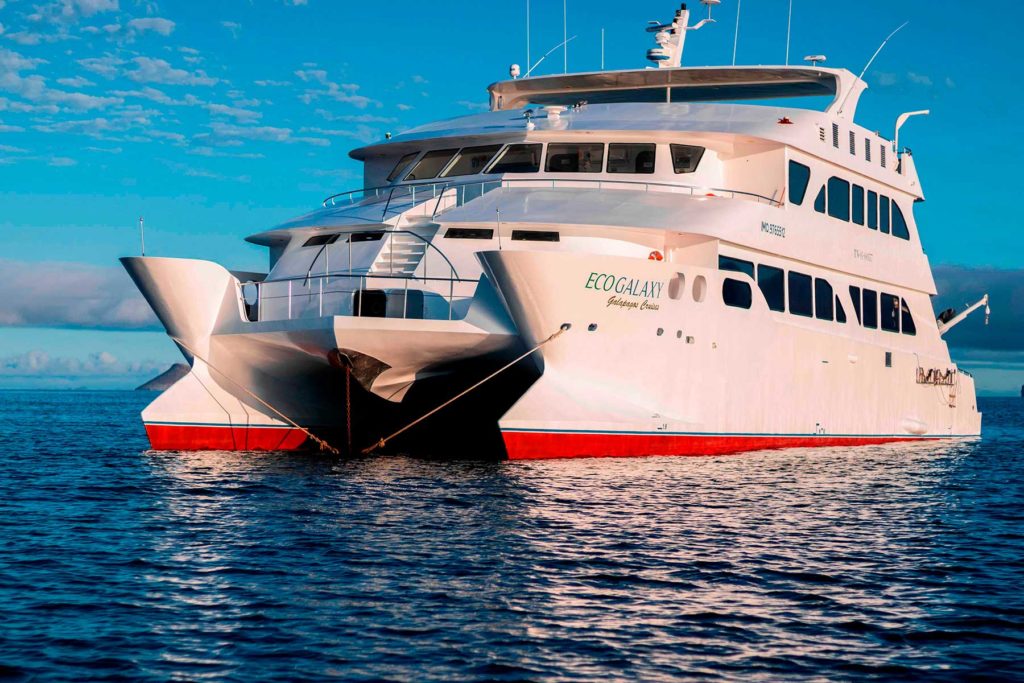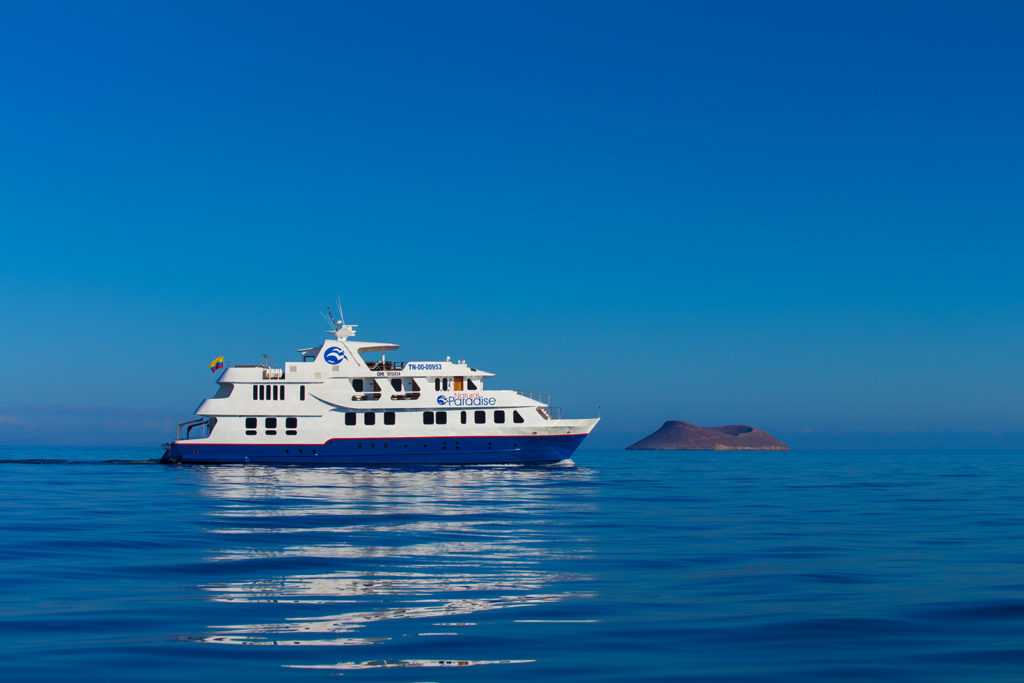- Features
- Includes
- Gallery
- Itinerary A
- Itinerary B
- itinerary C
Dimensions
- Length: 25 mts / 83 ft
- Beam: 6 mts / 22 ft
- Cruising speed: 9 knotsWater capacity: 2500 gallons
- Capacity: 16 passengers
- 8 crew members + 1 bilingual guide
- Motor: 2 Caterpillar 8 cylinder motors
- 6 lifebuoys
- 2 survival rafts, 15 passengers each
- 30 life jackets for passengers
- 20 life jackets for crew
- Flare gun, smoke signals, SOS flashlights signals
- CO2 extinguishers. Fire extinguishers
- Fire detectors and complete fire protection system. Fire suits
- External automated defibrillator
- Dinning room
- Lounge
- Sundeck
- Bunk beds.
- Endemic-style decoration
- Functional closets.
- Drawer desk
- Personalized air conditioning
INCLUDED
- Airport assistance
- Transfers in Galapagos
- Accommodations in double cabin
- All meals during the cruise
- Naturalist Bilingual Guide
- All visits & excursions according to the itinerary
- Snorkel Gear (mask, tube and fins). Kayaks
- Unlimited purified wáter, coffee and tea
- Wetsuit
- Local flight to/from Galapagos
- Galapagos National Park Entrance fee
- Galapagos Transit card
- Alcoholic drinks
- Tips
- Local taxes
- Travel insurance
- Service do not specified
ITINERARY A – WESTERN ROUTE
Day 1 - Sunday: Baltra Airport – Dragon Hill
Day 2 - Monday: Buccaneer Cove / Espumilla Beach – Egas Port
Day 3 - Tuesday: Vicente Roca Point – Espinoza Point
Day 4 - Wednesday: Urbina Bay – Tagus Cove
Day 5 - Thursday: Elizabeth Bay – Moreno Point
Day 6 - Friday: Charles Darwin Station – Highlands
Day 7 - Saturday: Twin Craters – Baltra Airport
DETAILED ITINERARY
DAY 1 - SUNDAY: BALTRA AIRPORT – DRAGON HILL
AM: BALTRA AIRPORT
Departure to the Galapagos Islands, arrival at Baltra airport, where our naturalist guide of the National Park will be waiting for you.
PM: DRAGON HILL
Located in the northern coast of Santa Cruz, Dragon hill gets its name from the land iguanas that inhabit this area, the only location in the whole island of Santa Cruz where you can see this large species of reptiles. Thanks to a very successful breeding program, this population of land iguanas, which was in the brink of extinction during the 70’s and 80’s, has rapidly recovered. There is also a small salt water lagoon where we can often see flamingoes, ducks, stilts, sandpipers and other shorebirds.
Snorkel: After the hike, you will have the option to snorkel in shallow sheltered water where you will see large schools of surgeonfish and parrotfish, as well as reef sharks, rays and a large diversity of tropical fish.
Trail: 2,2 km / 1,4 mi
Meals: Lunch, Dinner
Lodging: Yacht Bonita
DAY 2 - MONDAY: SANTIAGO ISLAND
AM: BUCCANEER COVE / ESPUMILLA BEACH
This site gets its name because it was used by buccaneers and pirates during the XVII and XVIII centuries to hide and get freshwater and tortoises. It is very scenic with beautiful cliffs and rock formations. There is no trail, but here you will take a dinghy to look at wildlife from the boats.
Snorkel: You can snorkel in a sheltered bay which is teaming with underwater wildlife including large schools of fish (angelfish, puffers, parrotfish, snappers, grunts…) but also reek sharks, sea lions and sea turtles.
Espumilla is a beautiful 1km (0,6 mi) long beach with rusty-brown sand, located in the northern coast of Santiago. It is surrounded by large mangrove trees and a very interesting native dry forest, which is home to Galapagos hawks but also a great diversity of finches, mockingbirds and doves. Trail: 2,3 km / 1,4 mi (plus and extra loop 1 km – 0,6 mi)
PM: EGAS PORT
The trail goes along the coastline which is rich in wildlife, with marine iguanas basking in the sun everywhere, Galapagos sea lions, herons, oystercatchers and many shorebirds. At the end of the trail an area called “the grottos” is home for a small colony of the endemic Galapagos fur seal, much more difficult to see at close range than its cousin. Trail: 2,3 km / 1,4 mi
Snorkel: You can snorkel from the beach and explore an area of rocky bottoms which is excellent for fish, turtles and reef sharks. Often, sea lions are also present and are happy to interact with divers.
Meals: Breakfast, Lunch, Dinner
Lodging: Yacht Bonita
DAY 3 - TUESDAY: VICENTE ROCA POINT – ESPINOZA POINT
AM: VICENTE ROCA POINT
Surrounded by some of the tallest cliffs in the Galapagos, Vicente Roca point is a great location to observe spectacular landscapes and interesting volcanic features. There is no trail here but you will take a dinghy tour along the shore to get a closer view of pelicans, flightless cormorants, sea turtles, boobies, Galapagos fur seal and marine iguanas.
Snorkel: Snorkel in the cove to look for sea turtles, penguins, sea lions, cormorants, rays and many different species of fish. Look for fan corals, sponges and other invertebrates growing on the walls.
AM: ESPINOZA POINT
Located at the base of an imposing volcano (the most active in the Galapagos islands) this site is one of the jewels of the Galapagos National Park. As soon as you disembark you will be surrounded by hundreds of marine iguanas, as this is the largest colony for the specie. Sea lions bask in the beaches while their pups play in tide pools. Along the shore you will see flightless cormorants, which are restricted to the western areas of the archipelago. Surrounded by cold plankton-rich waters, Punta Espinosa is home for an array of species, including herons, pelicans, oystercatchers, sea turtles, shorebird and many more. Look up in the mangroves as Galapagos hawks often perch to look for their prey. Trail: 1,6 km / 1 mi
Snorkel: The nutrient-rich waters around Punta Espinosa attracts great numbers and diversity of fish and sea turtles. Seaweeds are also abundant, making this place the best for seeing marine iguanas feeding underwater. Following a cormorant underwater as it chases fish through the reef is one on the most amazing snorkel experiences you may have on your trip.
Meals: Breakfast, Lunch, Dinner
Lodging: Yacht Bonita
DAY 4 - WEDNESDAY: URBINA BAY – TAGUS COVE
AM: URBINA BAY
This place is known for the dramatic uplifting that happened here during the 1950’s. A large portion of the coast was pushed up, exposing many hectares of previously submerged land. Look carefully along the trail and you will find small shells and corals, a proof that the area was underwater more than sixty years ago. The trail will give the opportunity to see land iguanas and, during certain seasons, giant tortoises. Galapagos hawks nest in the area and are often seen flying or perched on the trees.
Trail: Short trail: 1,2 km / 0,7 mi. Long Trail: 3,0 km / 1,8 mi
Snorkel: You can snorkel from the beach to see sea turtles, cormorants and penguins. Fish
are also abundant in the area.
PM: TAGUS COVE
Tagus cove is one of the places Charles Darwin visited during his exploration of the Galapagos islands. A trail will take you through a dry Palo Santo forests where you can see Darwin finches and mockingbirds. You will get great views of Darwin’s lake and the large volcanos of northern Isabela.
A boat tour along the shore will give you chances to see penguins, cormorants, marine iguanas and a very unique species: the Galapagos martin, a small endemic bird which is one of the most endangered species on the island. Trail: 2,6 km / 1,6 mi
Snorkel: The nutrient-rich waters around Tagus Cove attracts a lot of sea turtles and a great diversity of fish, but also penguins, who feast on large schools of anchovies. It is common to see cormorants underwater as they chase fish through the reef.
Meals: Breakfast, Lunch, Dinner
Lodging: Yacht Bonita
DAY 5 - THURSDAY: ELIZABETH BAY – MORENO POINT
AM: ELIZABETH BAY
Elizabeth Bay is a beautiful sheltered bay surrounded by large mangroves and barren lava fields. There is no trail here so you will take a dinghy tour to explore many channels, pools and coves teeming with life. This is one of the best locations in the islands to see Galapagos penguins, but don’t expect to see thousands of them, as the entire population of the islands is only about 3.000 of them. Flightless cormorants also nest in the area and blue-footed boobies and pelicans often fish in these shallow and rich waters. Rays and sea turtles are also very abundant.
PM: MORENO POINT
Moreno Point is a magical place with extensive lava fields which look lifeless at first sight. Once inland, scattered brackish lagoons form oasis of life where you can find flamingoes, gallinules, ducks and herons. Along the shore we will look for penguins, marine iguanas, flightless cormorants, blue-footed boobies, sea lions, oystercatchers and other shore birds.
Trail: 1,6 km / 1 mi
Snorkel: We will snorkel to see sea turtles, cormorants and many species of fish. Look carefully in the long seaweeds and you might find a sea horse.
Meals: Breakfast, Lunch, Dinner
Lodging: Yacht Bonita
DAY 6 - FRIDAY: CHARLES DARWIN STATION – SANTA CRUZ HIGHLANDS
AM: CHARLES DARWIN STATION
The Charles Darwin Station is a nonprofit organization which has been working for decades together with the Galapagos National Park to preserve the biodiversity of these unique islands. During this visit you will learn about the projects that both institutions carry together to protect the native species and eradicate the invasive ones which are threatening the Galapagos environment. One of the most important and emblematic projects has been reproducing giant tortoises in captivity. The visit is mostly outdoors in a beautiful dry native forest with giant cactus and many other interesting native plants. It is also a fantastic place to find several endemic Darwin finches, as well as flycatchers and mockingbirds.
Trail: 2 km / 1,2 mi
PM: HIGHLANDS
Either if you do this visit starting from Baltra or from Puerto Ayora, a bus will take you to the highlands stopping along the way at one of the reserves to visit the lush highland forests where you will look for Galapagos Giant tortoises in their natural environment. This is the best place in the Galapagos to see these gentle giants (reaching over 300 kg / 600 pounds!) casually grazing and resting in freshwater ponds. This is also home for a great diversity of birds rarely found at the lowlands, including finches (tree, woodpecker and vegetarian finches), flycatchers and several species of water birds. You will visit a lava tunnel (depend on the itinerary) and learn how these extraordinary formations where created by ancient volcanic eruptions.
Trail: 1-1,5 km / 0,6-0,9 mi
Meals: Lunch, Dinner
Lodging: Yacht Bonita
DAY 7 - SATURDAY: TWIN CRATERS – BALTRA AIRPORT
AM: TWIN CRATERS
The Twin Craters or also known as “Los Gemelos”, are located on the way to the Highlands of Santa Cruz Island. You will find them on both sides of the road leading from Puerto Ayora to Baltra. In fact, they are not real craters, they were created by the collapse of surface material in underground fissures and chambers. You will have a wonderful view of the local flora, like Scalesia plants. On this site it is also possible to observe the endemic short-ear owl. Then, transfer to the airport to take your flight back to continental Ecuador.
Meals: Breakfast
ITINERARY A – WESTERN ROUTE
Day 1 - Sunday: Baltra Airport – Dragon Hill
Day 2 - Monday: Buccaneer Cove / Espumilla Beach – Egas Port
Day 3 - Tuesday: Vicente Roca Point – Espinoza Point
Day 4 - Wednesday: Urbina Bay – Tagus Cove
Day 5 - Thursday: Elizabeth Bay – Moreno Point
Day 6 - Friday: Charles Darwin Station – Highlands
Day 7 - Saturday: Twin Craters – Baltra Airport
DETAILED ITINERARY
DAY 1 - SUNDAY: BALTRA AIRPORT – DRAGON HILL
AM: BALTRA AIRPORT
Departure to the Galapagos Islands, arrival at Baltra airport, where our naturalist guide of the National Park will be waiting for you.
PM: DRAGON HILL
Located in the northern coast of Santa Cruz, Dragon hill gets its name from the land iguanas that inhabit this area, the only location in the whole island of Santa Cruz where you can see this large species of reptiles. Thanks to a very successful breeding program, this population of land iguanas, which was in the brink of extinction during the 70’s and 80’s, has rapidly recovered. There is also a small salt water lagoon where we can often see flamingoes, ducks, stilts, sandpipers and other shorebirds.
Snorkel: After the hike, you will have the option to snorkel in shallow sheltered water where you will see large schools of surgeonfish and parrotfish, as well as reef sharks, rays and a large diversity of tropical fish.
Trail: 2,2 km / 1,4 mi
Meals: Lunch, Dinner
Lodging: Yacht Bonita
DAY 2 - MONDAY: SANTIAGO ISLAND
AM: BUCCANEER COVE / ESPUMILLA BEACH
This site gets its name because it was used by buccaneers and pirates during the XVII and XVIII centuries to hide and get freshwater and tortoises. It is very scenic with beautiful cliffs and rock formations. There is no trail, but here you will take a dinghy to look at wildlife from the boats.
Snorkel: You can snorkel in a sheltered bay which is teaming with underwater wildlife including large schools of fish (angelfish, puffers, parrotfish, snappers, grunts…) but also reek sharks, sea lions and sea turtles.
Espumilla is a beautiful 1km (0,6 mi) long beach with rusty-brown sand, located in the northern coast of Santiago. It is surrounded by large mangrove trees and a very interesting native dry forest, which is home to Galapagos hawks but also a great diversity of finches, mockingbirds and doves. Trail: 2,3 km / 1,4 mi (plus and extra loop 1 km – 0,6 mi)
PM: EGAS PORT
The trail goes along the coastline which is rich in wildlife, with marine iguanas basking in the sun everywhere, Galapagos sea lions, herons, oystercatchers and many shorebirds. At the end of the trail an area called “the grottos” is home for a small colony of the endemic Galapagos fur seal, much more difficult to see at close range than its cousin. Trail: 2,3 km / 1,4 mi
Snorkel: You can snorkel from the beach and explore an area of rocky bottoms which is excellent for fish, turtles and reef sharks. Often, sea lions are also present and are happy to interact with divers.
Meals: Breakfast, Lunch, Dinner
Lodging: Yacht Bonita
DAY 3 - TUESDAY: VICENTE ROCA POINT – ESPINOZA POINT
AM: VICENTE ROCA POINT
Surrounded by some of the tallest cliffs in the Galapagos, Vicente Roca point is a great location to observe spectacular landscapes and interesting volcanic features. There is no trail here but you will take a dinghy tour along the shore to get a closer view of pelicans, flightless cormorants, sea turtles, boobies, Galapagos fur seal and marine iguanas.
Snorkel: Snorkel in the cove to look for sea turtles, penguins, sea lions, cormorants, rays and many different species of fish. Look for fan corals, sponges and other invertebrates growing on the walls.
AM: ESPINOZA POINT
Located at the base of an imposing volcano (the most active in the Galapagos islands) this site is one of the jewels of the Galapagos National Park. As soon as you disembark you will be surrounded by hundreds of marine iguanas, as this is the largest colony for the specie. Sea lions bask in the beaches while their pups play in tide pools. Along the shore you will see flightless cormorants, which are restricted to the western areas of the archipelago. Surrounded by cold plankton-rich waters, Punta Espinosa is home for an array of species, including herons, pelicans, oystercatchers, sea turtles, shorebird and many more. Look up in the mangroves as Galapagos hawks often perch to look for their prey. Trail: 1,6 km / 1 mi
Snorkel: The nutrient-rich waters around Punta Espinosa attracts great numbers and diversity of fish and sea turtles. Seaweeds are also abundant, making this place the best for seeing marine iguanas feeding underwater. Following a cormorant underwater as it chases fish through the reef is one on the most amazing snorkel experiences you may have on your trip.
Meals: Breakfast, Lunch, Dinner
Lodging: Yacht Bonita
DAY 4 - WEDNESDAY: URBINA BAY – TAGUS COVE
AM: URBINA BAY
This place is known for the dramatic uplifting that happened here during the 1950’s. A large portion of the coast was pushed up, exposing many hectares of previously submerged land. Look carefully along the trail and you will find small shells and corals, a proof that the area was underwater more than sixty years ago. The trail will give the opportunity to see land iguanas and, during certain seasons, giant tortoises. Galapagos hawks nest in the area and are often seen flying or perched on the trees.
Trail: Short trail: 1,2 km / 0,7 mi. Long Trail: 3,0 km / 1,8 mi
Snorkel: You can snorkel from the beach to see sea turtles, cormorants and penguins. Fish
are also abundant in the area.
PM: TAGUS COVE
Tagus cove is one of the places Charles Darwin visited during his exploration of the Galapagos islands. A trail will take you through a dry Palo Santo forests where you can see Darwin finches and mockingbirds. You will get great views of Darwin’s lake and the large volcanos of northern Isabela.
A boat tour along the shore will give you chances to see penguins, cormorants, marine iguanas and a very unique species: the Galapagos martin, a small endemic bird which is one of the most endangered species on the island. Trail: 2,6 km / 1,6 mi
Snorkel: The nutrient-rich waters around Tagus Cove attracts a lot of sea turtles and a great diversity of fish, but also penguins, who feast on large schools of anchovies. It is common to see cormorants underwater as they chase fish through the reef.
Meals: Breakfast, Lunch, Dinner
Lodging: Yacht Bonita
DAY 5 - THURSDAY: ELIZABETH BAY – MORENO POINT
AM: ELIZABETH BAY
Elizabeth Bay is a beautiful sheltered bay surrounded by large mangroves and barren lava fields. There is no trail here so you will take a dinghy tour to explore many channels, pools and coves teeming with life. This is one of the best locations in the islands to see Galapagos penguins, but don’t expect to see thousands of them, as the entire population of the islands is only about 3.000 of them. Flightless cormorants also nest in the area and blue-footed boobies and pelicans often fish in these shallow and rich waters. Rays and sea turtles are also very abundant.
PM: MORENO POINT
Moreno Point is a magical place with extensive lava fields which look lifeless at first sight. Once inland, scattered brackish lagoons form oasis of life where you can find flamingoes, gallinules, ducks and herons. Along the shore we will look for penguins, marine iguanas, flightless cormorants, blue-footed boobies, sea lions, oystercatchers and other shore birds.
Trail: 1,6 km / 1 mi
Snorkel: We will snorkel to see sea turtles, cormorants and many species of fish. Look carefully in the long seaweeds and you might find a sea horse.
Meals: Breakfast, Lunch, Dinner
Lodging: Yacht Bonita
DAY 6 - FRIDAY: CHARLES DARWIN STATION – SANTA CRUZ HIGHLANDS
AM: CHARLES DARWIN STATION
The Charles Darwin Station is a nonprofit organization which has been working for decades together with the Galapagos National Park to preserve the biodiversity of these unique islands. During this visit you will learn about the projects that both institutions carry together to protect the native species and eradicate the invasive ones which are threatening the Galapagos environment. One of the most important and emblematic projects has been reproducing giant tortoises in captivity. The visit is mostly outdoors in a beautiful dry native forest with giant cactus and many other interesting native plants. It is also a fantastic place to find several endemic Darwin finches, as well as flycatchers and mockingbirds.
Trail: 2 km / 1,2 mi
PM: HIGHLANDS
Either if you do this visit starting from Baltra or from Puerto Ayora, a bus will take you to the highlands stopping along the way at one of the reserves to visit the lush highland forests where you will look for Galapagos Giant tortoises in their natural environment. This is the best place in the Galapagos to see these gentle giants (reaching over 300 kg / 600 pounds!) casually grazing and resting in freshwater ponds. This is also home for a great diversity of birds rarely found at the lowlands, including finches (tree, woodpecker and vegetarian finches), flycatchers and several species of water birds. You will visit a lava tunnel (depend on the itinerary) and learn how these extraordinary formations where created by ancient volcanic eruptions.
Trail: 1-1,5 km / 0,6-0,9 mi
Meals: Lunch, Dinner
Lodging: Yacht Bonita
DAY 7 - SATURDAY: TWIN CRATERS – BALTRA AIRPORT
AM: TWIN CRATERS
The Twin Craters or also known as “Los Gemelos”, are located on the way to the Highlands of Santa Cruz Island. You will find them on both sides of the road leading from Puerto Ayora to Baltra. In fact, they are not real craters, they were created by the collapse of surface material in underground fissures and chambers. You will have a wonderful view of the local flora, like Scalesia plants. On this site it is also possible to observe the endemic short-ear owl. Then, transfer to the airport to take your flight back to continental Ecuador.
Meals: Breakfast
ITINERARY C – NORTHERN ROUTE
Day 1 - Wednesday: Baltra Airport – Plazas
Day 2 - Thursday: Black Turtle Cove – Highlands
Day 3 - Friday: Darwin Bay – El Barranco
Day 4 - Saturday: Sullivan Bay – Bartolome
Day 5 - Sunday: Seymour – Baltra Airport
DETAILED ITINERARY
DAY 1 - WEDNESDAY: BALTRA AIRPORT – PLAZAS ISLAND
AM: BALTRA AIRPORT
Departure to the Galapagos Islands, arrival at Baltra airport, where our naturalist guide of the National Park will be waiting for you.
PM: PLAZAS
Of the two twin islands, only South Plazas is allowed to be visited, while North plazas is kept exclusively for scientific research. This is a small islet, but it packs an impressive amount of wildlife. Right after you land you will see Galapagos land iguanas waiting under prickly-pear cactus feed on their fruits. A large colony of sea lions will give you the opportunity to see playful pups enjoying the tide pools, but also large grumpy males defending their territories. The trail will take you to a cliff where you can observe many sea birds, such as frigatebirds, red-billed tropicbirds, boobies, swallow-tailed gulls and pelicans. A reddish succulent vegetation with scattered cactus covers most of the islands like a carpet, giving this island a unique personality.
Trail: 1,4 km / 0,8 mi
Meals: Lunch, Dinner
Lodging: Yacht Bonita
DAY 2 - THURSDAY: BLACK TURTLE COVE – SANTA CRUZ HIGHLANDS
AM: BLACK TURTLE COVE
Black Turtle Cove gets its name from the abundance of green see turtles, locally known as: “tortugas negras”. There is no landing here so you will be doing a boat tour on the dinghies, exploring shallow channels and small coves surrounded by beautiful mangrove forests. Reef sharks, sea turtles and several species rays inhabit this beautiful area which is considered an important mating area for turtles and a nursery for several species of sharks. Herons, pelicans and boobies are also common here as they prey in schools of anchovies.
PM: HIGHLANDS
Either if you do this visit starting from Baltra or from Puerto Ayora, a bus will take you to the highlands stopping along the way at one of the reserves to visit the lush highland forests where you will look for Galapagos Giant tortoises in their natural environment. This is the best place in the Galapagos to see these gentle giants (reaching over 300 kg / 600 pounds!) casually grazing and resting in freshwater ponds. This is also home for a great diversity of birds rarely found at the lowlands, including finches (tree, woodpecker and vegetarian finches), flycatchers and several species of water birds. You will visit a lava tunnel (depend on the itinerary) and learn how these extraordinary formations where created by ancient volcanic eruptions.
Trail: 1-1,5 km / 0,6-0,9 mi
Meals: Breakfast, Lunch, Dinner
Lodging: Yacht Bonita
DAY 3 - FRIDAY: GENOVESA ISLAND
AM: DARWIN BAY
Genovesa is a favorite island for birdwatchers as it is home for very large colonies of seabirds. From the minute you set foot at the beach you will be amazed by the noise of hundreds of boobies, gulls and frigatebirds flying over your heads, perched in the bushes or nesting on the sandy terrain. The trail is an ultimate wildlife experience as there are animals everywhere; sea lions and marine iguanas near the sea; night herons, lava & swallow tailed gulls, Darwin finches, Galapagos doves, mockingbirds and many more species inland. Trail: 1,2 km / 0,7 mi
Snorkel: The bay offers several places to snorkel; from deep waters along the cliffs across the bay, to shallow waters by the beach. In either case, there are many fish to see and great chances of seeing sharks, rays and sea lions.
AM: EL BARRANCO
El Barranco is located in the southern part of Darwin Bay at Genovesa Island. The cliffs face the sea are made of very fragile fractured lava, making it the ideal place for storm petrel to build their colonies, which attracts an important population of short-eared owls preying of the nesting birds. Red footed and Nazca boobies are abundant along the trail. At the base of the cliffs you can see Galapagos fur seals resting in shaded areas, as well as several species of seabirds.
Snorkel: You can snorkel along the cliffs where there are many fish and great chances of seeing sharks, rays and sea lions.
Trail: 1,2 km / 0,7 mi
Meals: Breakfast, Lunch, Dinner
Lodging: Yacht Bonita
DAY 4 - SATURDAY: SULLIVAN BAY – BARTOLOME ISLAND
AM: SULLIVAN BAY
This hike is a journey into understanding the birth of these volcanic islands. You will walk in a very well preserved flow of Pahoehoe lava, which will give you endless opportunities to see the delicate textures of these type of lavas which only appear in a few places throughout the world. At first sight the barren landscape looks completely deprived of life, but look carefully for pioneer plants, lava lizards and small birds. By the shore, you can find penguins, pelicans and oystercatchers. Trail: 2,2 km / 1,4 mi
Snorkel: You will have the option to swim or snorkel from a coral sand beach. Getting underwater is like traveling to another world: if the land is almost lifeless, the sea is teaming with life, including large schools of fish, Galapagos penguins, reef sharks, turtles and rays.
PM: BARTOLOME
Bartolome is one of the most iconic places in the Galapagos and one of the few where you can see penguins without going to the remote areas of western Isabela and Fernandina. You will get great views of Pinnacle Rock, located in the northern side of the island, right next to a beautiful peach-color sand beach. The hike to the top of the island is fantastic and will offer you incredible views of lunar landscapes with scattered volcanic cones. Many islands are visible from this outlook. Trail: 1,5 km / 0,9 mi
Snorkel: You will have the option to swim or snorkel from the beach. This area holds a well-deserved reputation of being one of the best snorkeling places in the Galapagos because of the presence of penguins, which are relatively easy to find while snorkeling, along with an incredible diversity of fish, colorful invertebrates, sea lions, turtles, rays and reef sharks.
Meals: Breakfast, Lunch, Dinner
Lodging: Yacht Bonita
DAY 5 - SUNDAY: SEYMOUR – BALTRA AIRPORT
AM: SEYMOUR
This island is home for large colonies of both magnificent and great frigatebirds and you can see them displaying their red balloons to attract a female. Blue-footed boobies nest in the ground and perform their famous dance in the open areas, while swallow-tailed gulls perch on the cliff edges. Land iguanas are common inland while their marine cousins bask in the rocks by the sea, close to sea lions, which often like to body surf in the waves. Then, transfer to the airport to take your flight back to continental Ecuador.
Trail: 1,4 km / 0,8 mi
Snorkel: This place is a really great snorkeling location, as it has tremendous diversity and amount of fish, but also sea lions, sharks, eels, turtles, rays and many more.
Meals: Breakfast

